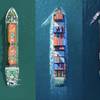US Navy Working to Lower Ships’ Fuel Costs
The rewards reaped from the Navy's Energy Conservation (ENCON) Program save millions in fuel costs, while keeping ships at sea to support the nation's Maritime Strategy.
ENCON includes two major energy conservation and management programs spearheaded by Naval Sea Systems Command (NAVSEA) in One is the Incentivized Energy Conservation (i-ENCON) Program; the other is the Fleet Readiness, Research and Development Program (FRR&DP).
According to i-ENCON Program Manager Hasan Pehlivan, the programs are projected to save more than 1.14 million barrels of oil in 2008, enough to fill four million 12-gallon car gas tanks, resulting in a record cost avoidance of more than $157 million.
"Like the average consumer, the Navy's budget today is challenged by increasing fuel costs," FRR&DP Program Manager Petter Kristiansen said. "These programs are designed to help the fleet conserve fuel now through changed operating procedures and to find long-term fuel reduction solutions that enable us to meet mission requirements even when fuel prices go through the roof."
The i-ENCON program is a hands-on, "meet the fleet" initiative that routinely meets with ship operators to review specific fuel-saving operational procedures and recommends quarterly awards for ships with the most fuel-efficient operations. In the late 1990s implemented several initiatives that have reduced fuel consumption for almost two decades.
The second program, FRR&DP, kicked off in October 2007. The program examines new technologies available today that offer reduced fuel consumption and significant return on investment (ROI) but must be tested and validated before implemented throughout the fleet.
The i-ENCON Program created a $104 million cost avoidance in 2007 and a then-record $125 million savings in 2006. In 2002, the i-ENCON Program Managers won the prestigious White House Presidential Award for Outstanding Federal Energy Management.
Committed to reducing ships' energy consumption by 10 percent each year, i-ENCON provides ships' commanding officers and chief engineers energy-saving strategies and techniques along with consumption-reducing procedures and operations modifications. The i-ENCON team's training and awareness programs includes videos, packet books and specialized software.
The i-ENCON training focuses on "smart steaming," engineering procedures and guidelines that ensure maximum fuel efficiency for ships without impairing mission objectives. These procedures include running only those systems and power plants needed to support the mission. "Ship loading," the proper placement of ship's cargo and ballast to ensure balanced weight distribution, is another smart steaming procedure.
According to Pehlivan, i-ENCON distributes quarterly fuel usage reports based on the Navy Energy Usage Reporting Systems (NEURS) which detail the energy consumption of surface ships. The leading fuel conservers among underway surface ships receive special recognition and cash incentives upwards of $90,000. Pehlivan said -- on average -- 100 ships qualify for cash awards each quarter.
The award money goes to commanding officers' discretionary funds, which are often used to buy items like damage control gear or to augment the ships' welfare and recreation programs.
"The incentives are very important to i-ENCON's success," Pehlivan added. "It's a volunteer program that requires real commitment from ships' commanding officers, chief engineers and main propulsion assistants.
"I receive calls and emails from ships everyday wanting to know how they can participate and improve their fuel performance."
FRR&DP initiatives project more than $19 million in annual cost avoidance when implemented, primarily in fuel savings, according to Kristiansen. The projected annual fuel savings equate to more than 134,000 barrels, enough to fill tanks in 469,000 cars.
"Among FRR&DP's five initiatives, the stern flaps for dock landing ships (LSDs) and the stern flaps for multi-purpose assault ships (LHDs) initiatives should yield annual cost avoidance of around $6.3 million," Kristiansen said.
The initiatives propose installing stern flaps on LSDs and LHDs, making the ships more hydrodynamic and thereby reducing the energy required to propel them. He cited earlier initiatives in which stern flaps were installed on destroyers (DDGs), cruisers (CGs) and frigates (FFGs), generating annual cost avoidance of $365,000 to $450,000 per ship, based on $96 per barrel of oil.
Another promising FRR&DP initiative, the Combustion Trim Loop, will replace obsolete boiler control system components on general purpose assault ships (LHAs) and LHDs. The new components will allow system operators to adjust boiler inputs for maximum efficiency. This offers a potential avoidance of more than $3.6 million annually in fuel savings when implemented.
FRR&DP initiatives under consideration for next year include underwater hull anti-fouling coatings, solid state lighting and other energy-saving technologies that offer more efficient operations.












